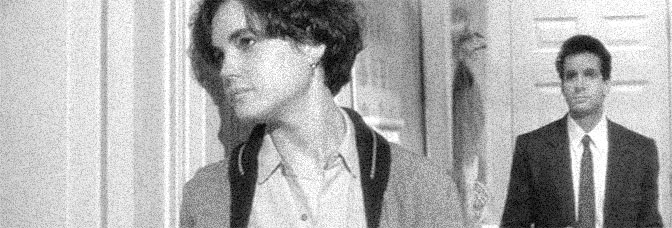Given The Bedroom Window was part of my VHS EP collection, I’ve lost count of how many times I’ve seen it. I do know I haven’t seen it in at least a decade and I also know this time is the first I’ve ever wondered about the source novel. The Bedroom Window is very busy; maybe director Hanson wants to distract the audience from where the movie’s going–which he really can’t since “guest star” Elizabeth McGovern gets second-billing–but maybe it’s from the novel. Maybe it’s a really long novel and Hanson, who also wrote the screenplay, had trouble adapting the pace.
But the novel’s only 200 pages. So it’s Hanson.
A good thriller, not even a great one, needs some fusion between the storytelling and the filmmaking. Hitchcockian means the way the film tells the tricky narrative. Or at least, it needs to have that definition. Because bewildered straight man in trouble isn’t Hitchcockian. It’s pedestrian. In The Bedroom Window’s case, the bewildered straight man is Steve Guttenberg. If it weren’t for Guttenberg’s rather buff physic, it might be funny having Guttenberg do a thriller. But it’s not a spoof, it’s Guttenberg trying.
He doesn’t do well. But he’s affable, surrounded by a lot of good actors, and Hanson is trying just as hard to pull of Guttenberg’s performance. Even though it’s often tedious, The Bedroom Window tries. Well, except when it comes to the composition. Hanson and cinematographer Gilbert Taylor shoot Bedroom Window in Panavision and it doesn’t need it. About the only thing the film’s got going for it visually is the Baltimore locations. Taylor’s photography is pretty flat–even though there are lots of eighties wet streets at night shots–but well-lighted. The city looks amazing and you want to see more of it. It gives Window some slack, which the film always needs.
Guttenberg’s an office guy–he has no responsibilities–who starts schtupping his boss’s wife, Isabelle Huppert in a ludicrous performance in a ludicrous role. Huppert witnesses Elizabeth McGovern getting assaulted, but Guttenberg plays witness to keep the affair a secret. This concept might have worked as late as the early sixties, but it’s just unbelievable in 1987. Hanson’s constantly trying to get away from police procedure, lawyer stuff, because he knows he’s peddling a malarky handling of it.
Instead, he introduces a subplot about Robert Schenkkan’s district attorney–trying rape cases–a complete pig. Only then, almost immediately following a big plot twist, we’re supposed to like Schenkkan again. Why make him a pig? Misdirection. Hanson is not a master. He’s not even moderately adept.
But he’s also ambitious in how responsible he wants to be; he’s trying not to make the film feel exploitative. Though one has to wonder why Huppert, given she and Guttenberg have zero chemistry, other than her willingness to disrobe. When Elizabeth McGovern finally shows up as something other than an object–which, quite frustratingly, isn’t until her second or third scene in the film–she gets a lot of good stuff to do. Even when the content is questionable, McGovern’s performance and Hanson’s handling of her performance are stellar. As much as Hanson wants to sell Steve Guttenberg as Jimmy Stewart, he wants McGovern to have a good part.
He just doesn’t know how. He’s sincere about Bedroom Window, which carries over. You want it to be better. Like the music from Michael Shrieve and Patrick Gleeson. Ninety percent of it is disposable smooth jazz. That other ten percent of it is slightly less disposable smooth jazz. But you still want to hope for it. Like the score will eventually get better. It doesn’t.
Great supporting cast–Carl Lumbly, Wallace Shawn, Frederick Coffin, Brad Greenquist, Maury Chaykin–Hanson uses them for temporary amusement. Actually, lots of people in The Bedroom Window are just “guest starring,” which also leads to it feeling like a two-night TV movie event cut down to one VHS tape.
Real strong editing from Scott Conrad. It occasionally goes bad because of Hanson’s bad ideas, but real strong otherwise. He’s better at editing the dramatic than the suspense.
The Bedroom Window is almost significant for McGovern’s performance. She’s great. But the script’s not there and Hanson’s got too many problems. Instead, it’s a curious bit of eighties popular cinema with some fantastic shots of Baltimore.
 ★½
★½
CREDITS
Directed by Curtis Hanson; screenplay by Hanson, based on a novel by Anne Holden; director of photography, Gil Taylor; edited by Scott Conrad; music by Michael Shrieve and Patrick Gleeson; production designer, Ron Foreman; produced by Martha De Laurentiis; released by De Laurentiis Entertainment Group.
Starring Steve Guttenberg (Terry Lambert), Elizabeth McGovern (Denise Connelly), Isabelle Huppert (Sylvia Wentworth), Paul Shenar (Collin Wentworth), Carl Lumbly (Det. Quirke), Frederick Coffin (Det. Jessup), Brad Greenquist (Carl Henderson), Robert Schenkkan (State Attorney Peters), Maury Chaykin (Pool Player) and Wallace Shawn (Henderson’s Attorney).
RELATED

Leave a Reply